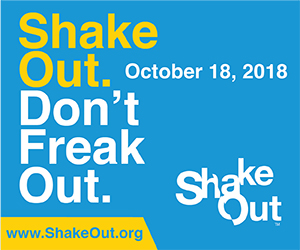Test Your Preparedness at the World’s Largest Earthquake Drill!
Join the local Red Cross tomorrow, October 18, for an international earthquake drill called the “Great ShakeOut”. More than 59 million people around the world will practice “drop, cover and hold on” tomorrow as part of the world’s largest earthquake drill. Individuals, businesses and various government agencies in the Cascades Region (Oregon and Southwest Washington) will stop what they’re doing at 10:18 a.m. to practice the safest known method to protect yourself during an earthquake.

In the Pacific Northwest, we are fortunate to live in a majestic and beautiful landscape. However, that very landscape was formed over time by lots of powerful earthquakes that created the landmarks we know and love: stunning mountain ranges studded by the likes of Mt. Hood, Mt. St. Helens and the Three Sisters, as well as beautiful waterways like the Columbia River Gorge. Given what we know about the dynamic evolution of our region, it’s important to be prepared for the possibility of a major earthquake in our lifetime.
Depending on what part of our region you live in, you may be susceptible to several minutes of intense shaking, a tsunami (if you’re on the coast) and landslides as a result of liquefaction of soil. In addition, we can expect that many bridges will collapse, potentially isolating communities for days or weeks from first responders and communications capabilities. Many buildings will also become uninhabitable. A Cascadia Subduction Zone earthquake could happen at any time, with little to no warning. All of this means that it’s important for people in the Cascades Region to start getting ready now so they are prepared for when disaster does strike.
Getting you and your family ready for an emergency like a Cascadia earthquake doesn’t have to be overwhelming. Start small, by building up your emergency supplies kit item by item, one week at a time. Make sure you have two weeks’ worth of water stored in your home—this means storing one gallon of water per person per day. And pick up a few extra canned goods on each trip to the grocery store to create an emergency food supply.
Here are a few questions to ask yourself to find out how prepared you are
for an emergency:
- Do you know the potential disasters that can happen in your area?
- Do you know how you will get in touch with loved ones following a disaster?
- Do you have an emergency supplies kit?
- If you already have a kit, are the supplies adequate and up-to-date?
Our Red Cross Prepare Guide includes all of this information and more to help you get prepared for disasters of all kinds. Start getting ready today by downloading the guide here.
To find out more about the Great ShakeOut and to
register to participate, visit www.shakeout.org.